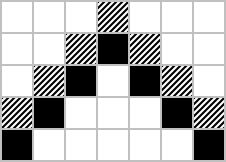Those of you familiar with Conway’s Game of Life probably know of its two most basic spaceships: the glider and the lightweight spaceship (shown below). The glider travels diagonally by one cell every four generations (and thus its speed is said to be “c/4”) and the lightweight spaceship travels orthogonally by two cells every four generations (and so its speed is denoted by “2c/4” or “c/2”).
 The glider |
 Lightweight spaceship |
A natural question to ask is whether or not there are any spaceships that travel faster than c/4 diagonally or c/2 orthogonally. John Conway proved in 1970 (very shortly after inventing the Game of Life) that the answer is no. I present this proof here, since it’s a bit difficult to find online (though Dave Greene was kind enough to post a copy of it on the ConwayLife.com forums).
Theorem 1. The maximum speed that a spaceship can travel in Conway’s Game of Life is c/4 diagonally and c/2 orthogonally.
Proof. We begin by proving the c/4 speed limit for diagonal spaceships. Consider the grid given in Figure 1 (below). If the spaceship is on and to the left of the diagonal line of cells defined by A, B, C, D, and E in generation 0, then suppose that cell X can be alive in generation 2.

Figure 1: The spaceship is to the left of A, B, C, D, and E
Well, if cell X is alive in generation 2, then cells C, U, and V must be alive in generation 1. This means that U and V must have had 3 alive neighbours in generation 0, so each of B, C, D, J, and K must be alive in generation 0. This means that C must have at least four live neighbours in generation 0 though, so there is no way for it to survive to generation 1, which gives a contradiction.
It follows that X can not be alive in generation 2. In other words, if the spaceship is behind the diagonal line A, B, C, D, E in generation 0, then it must be behind the diagonal line defined by U and V in generation 2. It follows that can not travel faster than c/4 diagonally.
To see the corresponding result for orthogonal spaceships, just use two diagonal lines as in Figure 2. If a spaceship is on and below the diagonal lines defined by the solid black cells in generation 0, then we already saw that it must be on and below the diagonal lines defined by the striped cells in generation 2. It follows that it can not travel faster than c/2 orthogonally.

Figure 2: The spaceship is on and below the solid black cells in generation 0
Notice that this result doesn’t only apply to spaceships, but also to other configurations that are (initially) finite and travel across the grid, such as puffers and wickstretchers. Also, this result applies to many Life-like cellular automata — not just Conway’s Game of Life.
In particular, these speed limits apply to any of the 212 = 4096 Life-like cellular automata in the range B3/S – B345678/S0123678. That is, these speed limits apply to any rule on the 2D square lattice such that birth occurs for 3 neighbours but not 0, 1, or 2 neighbours, and survival does not occur for 4 or 5 neighbours. But are the spaceship speed limits attained in each of these rules? The regular c/4 glider only works in the 28 = 256 rules from B3/S23 – B3678/S0235678. In the remaining rules, not much is known; some of them have c/3 orthogonal spaceships, some have c/5 orthogonal spaceships, and some have no spaceships at all (such as any of the rules containing S0123, which can not contain spaceships because the trailing edge of the spaceship could never die). Of particular interest are the sidewinder and this spaceship, which play the c/4 diagonal and c/2 orthogonal roles of the glider and lightweight spaceship, respectively, in B3/S13 (as well as several other rules).
So what about the other B3 (but not B0, B1, or B2) rules? If cells survive when they have 4 or 5 cells, then it’s conceivable that spaceships might be able to travel faster than c/4 diagonally or c/2 orthogonally because Theorem 1 does not apply to them. It turns out that they indeed can travel faster diagonally, but somewhat surprisingly they can not travel faster orthogonally.
Theorem 2. In any Life-like cellular automaton in which birth occurs when a cell has 3 live neighbours but not 0, 1, or 2 live neighbours, the maximum speed that a spaceship can travel is c/3 diagonally and c/2 orthogonally.
Proof. The trick here is to consider lines of slope -1/2 as in Figure 3 below. It is possible (though a bit more complicated) to prove the c/3 diagonal speed limit using a diagonal line as in Figure 1 for Theorem 1, but the orthogonal speed limit that results is 2c/3. What is presented here is the only method I know of proving both the diagonal speed limit of c/3 and the orthogonal speed limit of c/2.

Figure 3: The spaceship is below A, B, C, D, E, and F in generation 0
Suppose that a spaceship is on and below the line defined by the cells A, B, C, D, E, and F in Figure 3 in generation 0. It is clear that Y can not be alive in generation 2, since its only neighbour that could possibly be alive in generation 1 is K. Similarly, X can not be alive in generation 2 because its only neighbours that can be alive in generation 1 are B and K. It follows that in generation 2, the spaceship can not be more than 1 cell above the line A, B, C, D, E, F.
More mathematically, this tells us that the maximum speed of a spaceship that travels x cells horizontally for every y cells vertically can not travel faster than max{x,y}c/(x+2y). Taking x = y = 1 (diagonal spaceships) gives a speed limit of c/3. Taking x = 0, y = 1 (orthogonal spaceships) gives a speed limit of c/2.
Finally, it should be noted that even though these spaceship speed upper bounds apply to a wide variety of different rules, many rules don’t even have spaceships (even relatively simple rules containing B3 in their rulestring). For example, no spaceships are currently known in the rule “maze” (B3/S12345), and it seems quite believable that there are no spaceships to be found in that rule. I would love to see a proof that maze contains no spaceships, but it seems that there are too many cases to check by hand. I may end up trying a computer proof sometime in the near future.
 Lab #4: Continuity with Mario
Lab #4: Continuity with Mario














Recent Comments